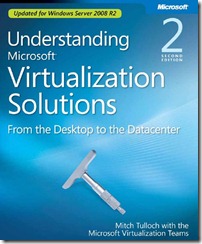Microsoft Virtualisation Free eBook Offer
Learn about the latest Microsoft Virtualisation technologies, including Hyper-V and Windows Azure. Download Understanding Microsoft Virtualisation R2 Solutions, written by industry expert Mitch Tulloch along with the Microsoft Virtualisation team.
Register to download Understanding Microsoft Virtualization Solutions, Second Edition (updated for Windows Server 2008 R2) from Microsoft Press.
Here's info from the eBook:
The primary target audience for this book is IT administrators, implementers, and decision makers of large and mid-sized organizations who want to learn about the benefits of the latest Virtualisation technologies and how to plan, implement, and manage virtual infrastructure solutions based on these technologies.
